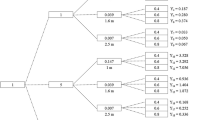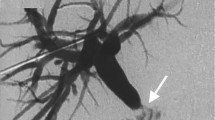Abstract
Background
For many years, intraoperative cholangiography during cholecystectomy to aid definition of the biliary anatomy and to detect choledocholithiasis has been advocated. Although radiation exposure in fluoroscopic procedures is a concern, few available data exist regarding the radiation exposure incurred during intraoperative cholangiography. This study aimed to determine the average radiation exposure sustained during this procedure.
Methods
Radiation dose data were recorded between 5 September 2007 and 21 July 2008 for 108 consecutive patients undergoing laparoscopic cholecystectomy with intraoperative cholangiography. Dose area product values were used to calculate the entrance skin dose, an indicator of potential skin damage, and the effective dose, an indicator of long-term cancer risk, for each patient.
Results
The median age of the 108 patients (67% females) included in the data analysis was 51 years (range, 17–87 years). The mean entrance skin dose during intraoperative cholangiography was 0.0069 ± 0.0066 Gy, and the mean effective dose was 0.18 ± 0.17 mSv. No results exceeded the threshold of 2 Gy for skin damage, and the lifetime risk for the development of new cancer due to intraoperative cholangiography was less than 0.001%.
Conclusion
Radiation doses administered during intraoperative cholangiography are safe and do not represent a contraindication to this procedure.

Similar content being viewed by others
References
Mirrizi P (1937) Operative cholangiography. Surg Gynecol Obstet 65:702–710
Connor S, Garden OJ (2006) Bile duct injury in the era of laparoscopic cholecystectomy. Br J Surg 93:158–168
Metcalfe MS, Ong T, Bruening MH, Iswariah H, Wemyss-Holden SA, Maddern GJ (2004) Is laparoscopic intraoperative cholangiogram a matter of routine? Am J Surg 187:475–481
International Commission on Radiological Protection (2000) Avoidance of radiation injuries from medical interventional procedures. ICRP Publication 85. Pergamon Press, Oxford
International Commission on Radiological Protection (2008) Recommendations of the ICRP annals of the ICRP v. 37/2-4. ICRP Publication 103. Elsevier, Stockholm
International Commission on Radiological Protection (1991) 1990 recommendations of the International Commission on Radiological Protection. ICRP Publication 60. Pergamon Press, Oxford
Miller DL, Balter S, Noonan PT, Georgia JD (2002) Minimizing radiation-induced skin injury in interventional radiology procedures. Radiology 225:329–336
Crawley MT, Rogers AT (2000) Dose-area product measurements in a range of common orthopaedic procedures and their possible use in establishing local diagnostic reference levels. Br J Radiol 73:740–744
Weerakkody RA, Walsh SR, Cousins C, Goldstone KE, Tang TY, Gaunt ME (2008) Radiation exposure during endovascular aneurysm repair. Br J Surg 95:699–702
Heyd RL, Kopecky KK, Sherman S, Lehman GA, Stockberger SM (1996) Radiation exposure to patients and personnel during interventional ERCP at a teaching institution. Gastrointest Endosc 44:287–292
Tsalafoutas IA, Paraskeva KD, Yakoumakis EN, Vassilaki AE, Maniatis PN, Karagiannis JA, Koulentianos ED (2003) Radiation doses to patients from endoscopic retrograde cholangiopancreatography examinations and image quality considerations. Radiat Prot Dosimetry 106:241–246
Williams JR (1997) Radiation doses to patients from endoscopic retrograde cholangiopancreatography examinations and image quality considerations. Br J Radiol 70:498–503
Efstathopoulos EP, Karvouni E, Kottou S, Tzanalaridou E, Korovesis S, Giazitzoglou E, Katritsis DG (2004) Patient dosimetry during coronary interventions: a comprehensive analysis. Am Heart J 147:468–475
Miller DL, Balter S, Cole PE, Lu HT, Schueler BA, Geisinger M, Cardella JF, George JS, Miller GL III, Anderson J (2003) Radiation doses in interventional radiology procedures: the RAD-IR study: part I: overall measures of dose. J Vasc Interv Radiol 14:711–727
Miller DL, Balter S, Cole PE, Lu HT, Berenstein A, Albert R, Schueler BA, Georgia JD, Noonan PT, Russell EJ, Malisch TW, Vogelzang RL, Geisinger M, Cardella JF, George JS, Miller GL III, Anderson J (2003) Radiation doses in interventional radiology procedures: the RAD-IR study: part II: skin dose. J Vasc Interv Radiol 14:977–990
Author information
Authors and Affiliations
Corresponding author
Rights and permissions
About this article
Cite this article
Karthikesalingam, A., Markar, S.R., Weerakkody, R. et al. Radiation exposure during laparoscopic cholecystectomy with routine intraoperative cholangiography. Surg Endosc 23, 1845–1848 (2009). https://doi.org/10.1007/s00464-008-0279-0
Received:
Accepted:
Published:
Issue Date:
DOI: https://doi.org/10.1007/s00464-008-0279-0




